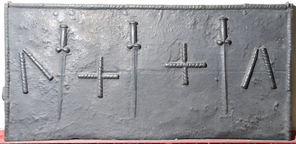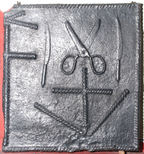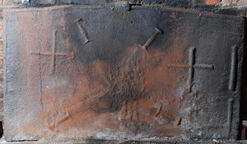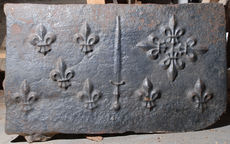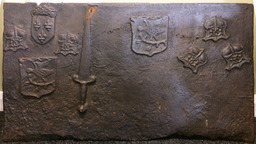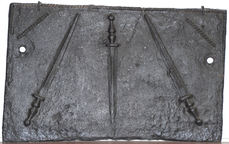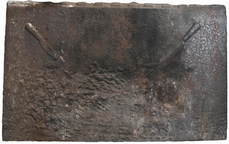-
1219
Description: Rectangular shape; twisted rope edging (top and sides); top centre, cross-shaped arrangement of four fleurs-de-lys between to crosses formed of lengths of twisted rope with single fleurs outside and beyond each of them a dagger, point upwards; to the right, a single fleur; bottom centre, a triangle formed of three lengths of twisted rope, vertex to the bottom, between two non-identical groups of three fleurs arranged in star pattern.
Notes: The style of the fleurs-de-lys associates this fireback with a series with several examples. The dagger type (approximate length 32cm) is different to others in the same series. Bishop & Miller Auctioneers, Stowmarket, 27 Jan 2022, lot 88 (£110).
- Decoration tags:
- rectangular (shape)
- rope (edging)
- simple stamps
- carved stamps
- heraldic
- apotropaic
- objects
Manufactured: in the mid- to late-16th century in the Weald area of England.
Current location: not known.
- Attached to series:
- Royal series
- Knife & Dagger stamp firebacks
- Fleur-de-lys firebacks
-
1100
Description: Quasi-rectangular shape with inward curving sides; twisted rope edging (top and sides); arrangement of fleurs-de-lys: top centre, four in a star formation with two horizontally below; two vertically to left and right; vertical dagger, pommel to base, stamped twice inside outer fleurs.
Notes: A uniquely shaped fireback with fleurs and daggers (each about 35cm long) seen on two other firebacks (no. 595 and no. 660).
- Decoration tags:
- rectangular (shape)
- rope (edging)
- simple stamps
- carved stamps
- heraldic
- objects
Manufactured: in the mid-16th century in the Weald area of England.
Current location: Sackville College, Church Lane, East Grinstead, West Sussex, England.
- Attached to series:
- Royal series
- Knife & Dagger stamp firebacks
- Fleur-de-lys firebacks
-
373
Description: Rectangular, edged with twisted leather lengths on top and sides; a ballock dagger with hollow-ground cruciform blade, point down, impressed vertically three times and evenly spaced across the width of the back; between each, two short lengths of twisted leather, arranged in a cross; at either end, the same short lengths of dowel arranged in an inverted ‘V’.
Notes: The dagger (length approx. 38cm) dates from c1575-1625. The probable use of twisted leather is seen occasionally on other firebacks. The grouping of three daggers may also have apotropaic significance in relation to the Trinity.
- Decoration tags:
- rectangular (shape)
- twisted leather (edging)
- simple stamps
- planklines
- apotropaic
- objects
Manufactured: in the late-16th to early-17th century in the Weald area of England.
Current location: Anne of Cleves House, Southover High Street, Lewes, East Sussex, England.
Museum number: 1944.24.035 (part of the Sussex Archaeological Society museum group)
- Attached to series:
- Knife & Dagger stamp firebacks
-
453
Description: Rectangular; twisted rope edging; irregular arrangement of three rope lengths at top left; rope cross above ‘V’ at middle bottom; impression of a pair of scissors between two impressions of a domestic table knife.
Notes: The knife is early-17th century in date or perhaps a bit earlier, just into Elizabeth I’s reign. The pommels date them from around this time and the long and narrow blades are right for the end of Elizabeth/early James I. The irregular rope lengths suggest this is probably part of a larger fireback.
- Decoration tags:
- rectangular (shape)
- rope (edging)
- simple stamps
- apotropaic
- objects
Manufactured: in the late-16th to early-17th century in the Weald area of England.
Current location: Anne of Cleves House, Southover High Street, Lewes, East Sussex, England.
Museum number: LH000.939 (part of the Sussex Archaeological Society museum group)
Citation: Moore, S., 1999, Cutlery for the Table (Sheffield, The Hallamshire Press).
-
1047
Description: Sub-rectangular shape, no edging; three impressions formed of a dagger (c.350mm) with fleur-de-lys terminals: two, at each end, with the handle uppermost, the other inverted lower right of centre.
Notes: The dagger (length approx. 39cm) can be described as a 'cross-hilt' or 'quillon' type, possibly of German origin (ex. inf. Tobias Capwell). The grouping of three daggers may also have apotropaic significance in relation to the Trinity. Formerly part of the J. H. Every collection.
- Decoration tags:
- rectangular (shape)
- none (edging)
- simple stamps
- apotropaic
- objects
Manufactured: in the 16th century in the Weald area of England.
Current location: Anne of Cleves House, Southover High Street, Lewes, East Sussex, England.
Museum number: LH000.920 (part of the Sussex Archaeological Society museum group)
- Attached to series:
- Knife & Dagger stamp firebacks
-
587
Description: Quasi-rectangular; grooved dowel edging (top and sides); four impressions of a rondel dagger (c.330mm) saltirewise between two dowel crosses; two vertical lengths of dowel in line along right edge.
Notes: Rondel daggers were common in the 15th and 16th century. Grooved lengths of dowel are to be seen on other firebacks suggesting a common source. The arrangement of the daggers (each approx. 35cm long) in a saltire may also have apotropaic significance.
- Decoration tags:
- rectangular (shape)
- grooved dowel (edging)
- simple stamps
- apotropaic
- objects
Manufactured: in the mid-16th century in the Weald area of England.
Current location: in private hands, Plaxtol, Kent, England.
- Attached to series:
- Grooved dowel series
- Knife & Dagger stamp firebacks
-
660
Description: Rectangular; plain plate; central, vertical cross-hilt dagger stamp; left side, fleur de lys stamp repeated five times, irregularly arranged in three rows, two above and below and one in the middle; right side, fleur de lys stamp repeated six times, four in a star above two in a row.
Notes: The dagger (length approx. 35cm), seen on two other firebacks (no. 595 and no. 1100), may have beeen of Italian manufacture. The form of the fleurs-de-lys identifies this fireback as one of the ‘Royal’ series, a large group bearing heraldic stamps.
- Decoration tags:
- rectangular (shape)
- none (edging)
- simple stamps
- carved stamps
- heraldic
- objects
Manufactured: in the mid-16th century in the Weald area of England.
Current location: Hole Park, Rolvenden, Kent, England.
- Attached to series:
- Knife & Dagger stamp firebacks
- Royal series
- Fleur-de-lys firebacks
-
1109
Description: Rectangular; plain edging; asymmetrical arrangement of stamps: top right, three 'renaissance' style shield stamps with a 'PL' monogram above two [?]bougets, in a triangular arrangement bases uppermost; top centre, a shield, indented at the top, charged with a bird upon a branch; top left, crowned shield of France Modern between two inverted 'PL' monogram shields above a bird shield; to the right, a broad bladed dagger, point uppermost.
Notes: The dagger is of the cinquedea style, introduced from Italy in the early-16th century, length approx. 38cm; the bird shield stamp has been seen on other firebacks. Wilkinson's Auctioneers, Doncaster, 24 Feb 2019, lot 534 (£650).
Inscription: PL [in five shields]
Arms: 'France Modern'
- Decoration tags:
- rectangular (shape)
- none (edging)
- simple stamps
- carved stamps
- heraldic
- monogram
- armorial
- royal
- objects
Manufactured: in the early- to mid-16th century in the Weald area of England.
Current location: not known.
- Attached to series:
- Bird shield series
- Knife & Dagger stamp firebacks
-
727
Description: Rectangular; twisted rope edging (top and sides); canted rope lengths across top corners; three impressions of a rondel dagger (c. 410mm) with a baluster-turned grip, the middle one per fess, pommel in chief, the other two on either side, per bend, points in chief.
Notes: The arrangement of daggers is similar to the arms of Vigures, of Launceston, Cornwall, but inverted; the plate has been pierced on each side for fixing to the back of the fireplace; the dagger (length approx. 41cm) may be of German design.
- Decoration tags:
- rectangular (shape)
- rope (edging)
- simple stamps
- objects
Manufactured: in the mid- to late-16th century possibly in the Weald area of England.
Current location: Victoria & Albert Museum, Cromwell Road, Kensington & Chelsea, Greater London, England.
Museum number: 896.1901 (part of the Victoria & Albert Museum museum group)
- Attached to series:
- Knife & Dagger stamp firebacks
-
1279
Description: Plain rectangular shape with chamfered and embattled top edge; impression of a utilitarian, domestic knife inclined, blade down, at an angle of about 45 degrees from inside the top corners; the knife measures about 20.5cm in length.
Notes: An unusual, if not unique, top edge. The form of the knife suggests a late-16th or early-17th century date. The uneven surface of the lower part of the fireback may have been caused by the pouring of the molten metal and the consequent disturbance of the casting sand of the mould.
- Decoration tags:
- rectangular (shape)
- none (edging)
- simple stamps
- objects
Manufactured: in the late-16th to early-17th century in the Weald area of England.
Current location: in private hands, Wadhurst, East Sussex, England.
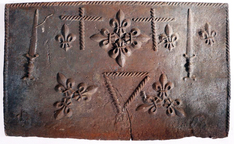
.jpg)
